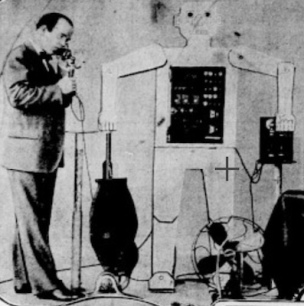One risk of reading Emilie Loring’s novels as often as I have is the tendency to skip or skim passages to get to the dialogue or action I crave. From time to time, though, I pay closer attention, and I’m rewarded, as I was in a recent re-reading of Swift Water (1929):


Even on re-reading, I sometimes slide past a reference I don’t know, deriving its meaning from context:
… liveried servants impersonal as the tribe Televox.
I’m a fan of “Downton Abbey;” I know the impersonal look she means: 
But “Televox?” This time, I wondered.
What sort of word is Televox? Greek, perhaps, like the mythological Ajax? His father was Telamon. Maybe Televox was his brother?
Meet Herbert Televox, “Televox” for short:

Televox was the 1920s robotic creation of Roy Wensley of Westinghouse. “Tele” came from telephone, “vox” meant the human voice, and the mechanism for the robot’s speech came from the “talking movie” industry. A section of moving-picture film was spliced into a loop that was “read” aloud when light passed through it.
At the outset, Televox could lift a telephone receiver (remember those?), throw some switches, and utter one of two simple sentences. If no one responded, Televox assumed a wrong number and hung up the phone.
“This is Televox speaking from Randolph 6400.”
That’s an actual quote from the robot in an October, 1928 Popular Science article. It’s a fine coincidence that Swift Water takes place in the home of Hugh Randolph. “Randolph 6400” would have been the telephone number “RA-6400,” or 72-6400.

Mr. Wensley praised his invention:
“For the first time in the history of a world that has long dreamed of and dreaded the coming of a mechanical man, it was possible to show such a man in his party clothes… a leader in the electron march to higher efficiency,”
In an unwitting commentary on the pre-Crash 1920s, he continued:
“He is a benevolent symbol of the age in which we live. Though he has neither a brain nor a soul, he has a heart.” Los Angeles Times, February 26, 1928
And the “tribe?”
“Considering what has already been accomplished in the development of this automaton, it will be a rash person indeed who would venture to predict now what the future limitations in other fields of usefulness for ‘Mr. Televox’ and his ‘children’ will be.” Craig Courier, July 25, 1928
Emilie Loring’s first readers knew Televox like we know “Downton Abbey.” I wasn’t wrong about the traditional demeanor of La Contessa Fanfani’s liveried servants. What I missed, though, was the contrast between old-fashioned livery and new-fangled robots. Once I saw it, I realized how strategically she used contrasts to describe the entire setting.
My former students will already be smiling at this point, knowing that I am about to say it: “Everything you learn allows you to see more.” 
Swift Water is a story about opposites and challenging expectations. Jean Randolph’s better self struggles with her “Terrible Twin,” and each of her parents represents a different side of her character–the father who is wise and caring, the mother who is remote and selfish. Expectations turn upside-down when a dark closet becomes a modern powder-room, liveried servants are compared to robots, and a minister is the town’s heartthrob.
Now, when I read this passage, I’ll see it differently. See if you do, too.
Antipasto gave way to brodo e parmagioni without registering the change in flavor or consistency. Each time she glanced under a fringe of lashes in Christopher Wynne’s direction–steel to magnet–she was provincially conscious of the bareness of her back. If only she had a scarf.
Tapers, a profusion of them–thin blades of light as many–heavy laces–color and scent of flowers–massive silver–crystal frail as a breath–sheen of velvet–flash of jewels–liveried servants impersonal as the tribe Televox–the glorious Fanfani theatrically effective in a high-back palace chair. Jean was subconsciously aware of it all as a background for her confused thought.
A minister! How could he be and look like that? He was so–so human.
The more I read, the more I appreciate Emilie Loring’s artistry–and the more I learn, the more I am rewarded by digging just a little deeper.




Grace Livingston Hill’s books are available for Kindle and by hovering over the word you don’t know, you can jettison to Wikipedia for definitions and explanations. Just began to read Emilie Loring and I am beginning with The Solitary Horseman because its setting is my hometown of Marlborough Massachusetts. “White Pillars” is now the funeral home in town which I have been to a few times over the years. Marlborough was once very pastoral with abundant apple orchards, so Loring got the descriptions accurately. I’m really enjoying it. Hollis Loring is buried in the Common Burial Ground situated behind the Jr. High I attended. I never knew any Loring’s from Marlborough but as it turns out, my father’s best friend was a grand nephew of Emelie’s and I just found this out a few years ago. Jack’s wife is still living and she has written to me about what she remembers of the family, now that I am interested in Loring’s books. I never made the connection between their last name “Loring” and the books. This part of the Loring family was very unique a big part of my childhood.
LikeLiked by 1 person
Donna, I am excited to hear from you and pleased to hear that Emilie Loring’s descriptions of Marlborough pass muster with the locals. How precious, to have first-hand memories about the Loring family. Whose descendants were they? Please share!
LikeLike
Thank you for checking on Televox. I tend to skip sometimes and that’s just me craving a fast read; so I missed this gem.
LikeLiked by 1 person
It was certainly unexpected! I had seen it before but assumed a far different identity than what turned out to be true. Now, I’ll have to be alert to similar items in her other books.
LikeLike
I just reread Swift Water last week and I slipped on past the Televox reference without it sinking in. This has to be one of her earliest books. Loved the descriptions of society in the 1920s, the changes in clothing and behavior from the previous decade which I’ve been researching for genealogy purposes. This one is a favorite of mine.
LikeLiked by 1 person
Thanks, Virginia. This was Emilie Loring’s sixth published novel, written in 1928/29. Since you’re interested in the era, let me recommend another site to you: https://marymiley.wordpress.com. I found it when looking for images of 1920s telephones, and I can’t wait to read more.
LikeLiked by 1 person
You probably are aware of Pixabay, a great source for free-use photos for bloggers. I found a great photo of an old wooden phone for use with a blog post about my grandmother. Usually, if I put in “vintage” or “retro” and my search term, Pixabay comes through for me.
LikeLike
Absolutely fascinating! I had never heard of Mr. Televox! Love your saying about learning. It does indeed pay to look deeper!
LikeLiked by 1 person
I was amazed to “find it” after reading this book… how many times?! That saying is my motto–and could be the motto for all of us who share experiences to lift, enlighten, enable, or entertain. From novels to aprons, little advances in understanding lift us all!
LikeLike